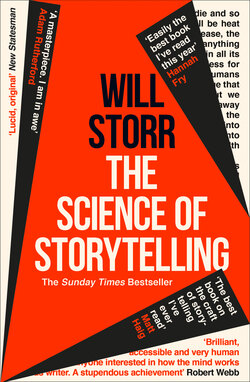Читать книгу The Science of Storytelling - Will Storr, Уилл Сторр - Страница 15
1.6
ОглавлениеAs the eye darts about, building up its story world for you to live inside, the brain’s choosy about where it tells it to look. We’re attracted to change, of course, but also to other salient details. Scientists used to believe attention was drawn simply to objects that stood out, but recent research suggests we’re more likely to attend to that which we find meaningful. Unfortunately, it’s not yet known precisely what ‘meaningful’ means, in this context, but tests that tracked saccades found, for example, that an untidy shelf attracted more attention than a sun-splashed wall. For me, that untidy shelf hints of human change; of a life in detail; of trouble insinuating itself in a place designed for order. It’s no surprise test-brains were drawn to it. It’s story-stuff, whilst the sun is just a shrug.
Storytellers also choose carefully what meaningful details to show and when. In Revolutionary Road, just after Frank makes his changeful theory-of-mind mistake that throws his life in a new and unexpected direction, the author draws our attention to one brilliant detail. It’s an urgent voice on the radio: ‘And listen to this. Now, during the Fall Clearance, you’ll find Robert Hall’s entire stock of men’s walk shorts and sport jeans drastically reduced!’
Both believable and crushing, it serves to intensify our feelings, at exactly the right moment, of the suffocating and dreary housewifey corner that April has found herself backed into. Its timing also implicitly defines and condemns what Frank has become. He used to think he was bohemian – a thinker! – and now he’s just Bargain Shorts Man. This is an advert for him.
The director Stephen Spielberg is famous for his use of salient detail to create drama. In Jurassic Park, during a scene that builds to our first sighting of Tyrannosaurus rex, we see two cups of water on a car dashboard, deep rumbles from the ground sending rings over their liquid surface. We cut between the faces of the passengers, each slowly registering change. Then we see the rear-view mirror vibrating with the stomping of the beast. Extra details like this add even more tension by mimicking the way brains process peak moments of stress. When we realise our car is about to crash, say, the brain needs to temporarily increase its ability to control the world. Its processing power surges and we become aware of more features in our environment, which has the effect of making time seem to slow down. In exactly this way, storytellers stretch time, and thereby build suspense, by packing in extra saccadic moments and detail.
